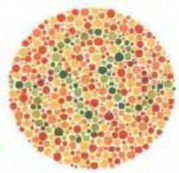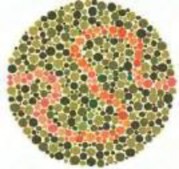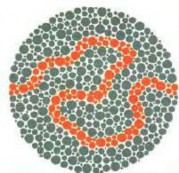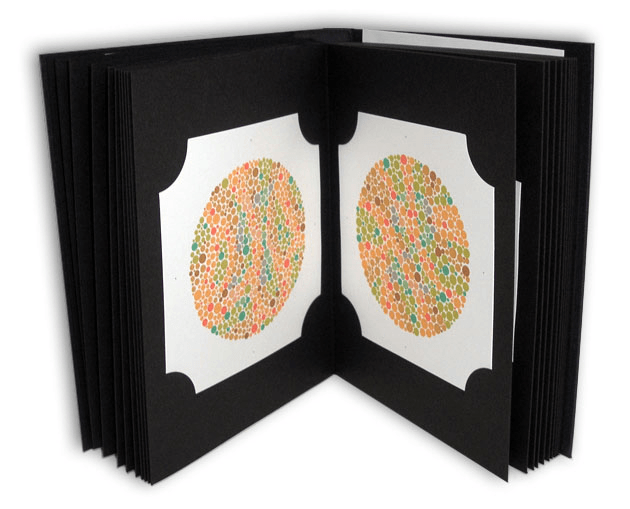Color Vision Test with the ISHIHARA System
The 38 ISHIHARA Plates
Download the overview:
Plate 1
Everyone should be able to see the number 12.
Plate 2
Normal vision: 8
Red-green deficiency: 3
Plate 3
Normal vision: 6 Red-green deficiency: 5
Plate 4
Normal vision: 29 Red-green deficiency: 70
Plate 5
Normal vision: 57 Red-green deficiency: 35
Plate 6
Normal vision: 5 Red-green deficiency: 2
Plate 7
Normal vision: 3 Red-green deficiency: 5
Plate 8
Normal vision: 15 Red-green deficiency: 17
Plate 9
Normal vision: 74 Red-green deficiency: 21
Plate 10
Normal vision: 2 Red-green deficiency: None or incorrect.
Plate 11
Normal vision: 6 Red-green deficiency: None or incorrect.
Plate 12
Normal vision: 97 Red-green deficiency: None or incorrect.
Plate 13
Normal vision: 45 Red-green deficiency: None or incorrect.
Plate 14
Normal vision: 5 Red-green deficiency: None or incorrect
Plate 15
Normal vision: 7 Red-green deficiency: None or incorrect
Plate 16
Normal vision: 16 Red-green deficiency: None or incorrect
Plate 17
Normal vision: 73 Red-green deficiency: None or incorrect
Plate 18
Normal vision: None Red-green deficiency: 5
Plate 19
Normal vision: None Red-green deficiency: 2
Plate 20
Normal vision: None Red-green deficiency: 45
Plate 21
Normal vision: None Red-green deficiency: 73
Plate 22
Normal vision: 26
Protanopia: 6 Deuteranopia: 2
Plate 23
Normal vision: 42
Protanopia: 2 Deuteranopia: 4
Plate 24
Normal vision: 35
Protanopia: 5 Deuteranopia: 3
Plate 25
Normal vision: 96
Protanopia: 6 Deuteranopia: 9
Plate 26
Normal vision: Purple and red dots Protanopia: Only purple line Deuteranopia: Only red line
Plate 27
Normal vision: Purple and red dots Protanopia: Only purple line Deuteranopia: Only red line
Plate 28
Normal vision: None Red-green deficiency: A line
Plate 29
Normal vision: None Red-green deficiency: A line
Plate 30
Normal vision: Blue-green line
Red-green deficiency: Nothing
Plate 31
Normal vision: Blue-green line
Red-green deficiency: Nothing
Plate 32
Normal vision: Orange line Red-green deficiency: None or a false line
Plate 33
Normal vision: Orange line Red-green deficiency: None or a false line
Plate 34
Normal vision: Blue-green and yellow-green lines Red-green deficiency: Only red-green and violet lines
Plate 35
Normal vision: Blue-green and yellow-green lines Red-green deficiency: Only blue-green and violet lines
Plate 36
Normal vision: Violet and orange lines Red-green deficiency: Blue-green and violet lines
Plate 37
Normal vision: Violet and orange lines Red-green deficiency: Blue-green and violet lines
Plate 38
Everyone should be able to see the same line.
Procedures for Conducting the Test with the ISHIHARA 38-Plate Edition
- Ensure that the test is conducted in a room with good, natural light or light with a color temperature of approximately 6500 Kelvin.
- Avoid direct sunlight or bright artificial light, which can affect the test results.
2. Patient’s Position:
- Seat the patient comfortably in a chair with the test book or cards placed at eye level.
- Maintain a distance of approximately 50 cm between the patient’s eyes and the test book.
3. Instructions to the Patient:
- Explain to the patient that they need to look at each image and identify the number or pattern they see.
- Inform the patient that it’s okay if they can’t see anything on some of the images.
4. Test Process:
- Show the patient one test card at a time for 3-5 seconds.
- Note the patient’s response without providing any hints or corrections.
- Ensure to cover both eyes separately if you wish to test each eye individually.
5. Evaluation of Results:
- Compare the patient’s responses with the correct answers provided below.
- Use the results to determine the type and degree of color blindness (e.g., red-green color blindness).
Interpretation:
If a person can correctly read 17 or more plates out of the first 21 plates, their color vision is considered normal. However, if the person can only correctly read 13 or fewer plates, it is interpreted as a red-green color deficiency. The individual identified with red-green deficiency will be shown diagnostic plates (22-25) to differentiate between protans (red deficiency) and deutans (green deficiency).
The number plates should be answered within 3 seconds, and the tracing should be completed within 10 seconds.
- The first type of plate is called a demonstration plate. This plate is used for demonstration purposes and for patients who are simulating. The numbers on the plates are read the same by everyone, whether they are normal, red-green deficient, or totally colorblind.
- The second type is transformation plates, from page 2 to 9. A number seen by a normal person appears differently to someone with red-green color deficiency. On plate number 2, a normal person will see 8, but a red-green colorblind person will read 3. Similarly, on plate number 3, a normal person will see 6, but a red-green deficient person will read 5. You can check the answer on the interpretation chart below.
- Next are the vanishing images from page 10 to 17. On these plates, a normal person can see numbers, but someone with red-green deficiency cannot see any number. So if you can’t read any number here, you might have a color vision deficiency.
- The next pages, from 18 to 21, are the hidden digit plates. These are the opposite of the vanishing plates, where a normal person cannot see any number, but a person with color vision deficiency can see numbers. So if you can’t see any numbers here, don’t worry, it’s a normal reaction.
- The fifth type is the diagnostic plates from page 22 to 25. They are used to differentiate between protans and deutans. Protans are those who have difficulty with red color, and deutans are those who have difficulty with green color. On these plates, protans can see digits on the right side, while deutans can see digits on the left side.
- Following this are the tracing plates from page 26 to 38 for a person who cannot read the numbers. The person is asked to trace the colored line from one X to the other.
| Plate Number | People with Normal Vision See: | People with Red/Green Deficiency See: | People with Total Colorblindness See: | |||
| Demonstration Plate | 1 | 12 | 12 | 12 | ||
| Transformation Plate | 2 | 8 | 3 | X | ||
| Transformation Plate | 3 | 6 | 5 | X | ||
| Transformation Plate | 4 | 29 | 70 | X | ||
| Transformation Plate | 5 | 57 | 35 | X | ||
| Transformation Plate | 6 | 5 | 2 | X | ||
| Transformation Plate | 7 | 3 | 5 | X | ||
| Transformation Plate | 8 | 74 | 21 | X | ||
| Transformation Plate | 9 | 15 | 17 | X | ||
| Vanishing Plate | 10 | 45 | X | X | ||
| Vanishing Plate | 11 | 5 | X | X | ||
| Vanishing Plate | 12 | 73 | X | X | ||
| Vanishing Plate | 13 | 45 | X | X | ||
| Vanishing Plate | 14 | 5 | X | X | ||
| Vanishing Plate | 15 | 7 | X | X | ||
| Vanishing Plate | 16 | 26 | X | X | ||
| Vanishing Plate | 17 | 42 | X | X | ||
| Hidden Digit Plate | 18 | X | 5 | X | ||
| Hidden Digit Plate | 19 | X | 2 | X | ||
| Hidden Digit Plate | 20 | X | 45 | X | ||
| Hidden Digit Plate | 21 | X | 73 | X | ||
| Protan – Red Problems | Deutan – Green Problems | |||||
| Severe | Mild | Severe | Mild | |||
| Diagnostic Plate | 22 | 26 | 6 | (2) 6 | 2 | 2 (6) |
| Diagnostic Plate | 23 | 42 | 2 | (4) 2 | 4 | 4 (2) |
| Diagnostic Plate | 24 | 35 | 5 | (3) 5 | 3 | 3 (5) |
| Diagnostic Plate | 25 | 96 | 6 | (9) 6 | 9 | 9 (6) |
| Tracing Plate | 26 | |||||
| Tracing Plate | 27 | |||||
| Tracing Plate | 28 | |||||
| Tracing Plate | 29 | |||||
| Tracing Plate | 30 | |||||
| Tracing Plate | 31 | |||||
| Tracing Plate | 32 | |||||
| Tracing Plate | 33 | |||||
| Tracing Plate | 34 | |||||
| Tracing Plate | 35 | |||||
| Tracing Plate | 36 | |||||
| Tracing Plate | 37 | |||||
| Tracing Plate | 38 | |||||
![]()















































